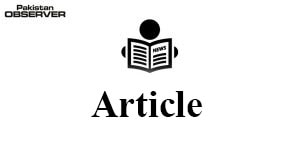Economic achievements
NATIONAL economy had been facing volatile pattern of growth over the years, with regular boom and bust cycles facing challenges in achieving long-term and inclusive growth.
Unsustainable economic growth was caused by over-due but not addressed long-standing structural issues for instance, loss-making State-Owned Enterprises (SOEs), weak external position due to insufficient export capacity and low Foreign Direct Investment (FDI), under-reformed energy sector, low savings and investment.
In the backdrop of these challenges, the incumbent federal government has focused on an economic vision of securing sustainable economic growth by improving efficiency, reducing cost of doing business, improving regulatory environment, enhancing productivity and increasing investment.
Even before the pandemic of COVID-19 had hit the national economy, the incumbent government had started implementing decisive and far-reaching reforms in every sector of the economy.
The reforms started to address the economic imbalances and laid the foundation for improved economic performance in terms of strengthened fiscal and external accounts, exchange rate stability and improved investors’ confidence.
Moreover, inflation started to stabilize and market confidence greatly recovered and appreciably improved.
Quite obviously, these reforms had paved the way for long-term growth and resultantly lead towards ending the unsustainable growth pattern that had plagued the national economy somehow for years together in the past.
The FY2021 began in the midst of the most severe global health crisis experienced by humanity in modern history.
Pakistan’s economy, like rest of the world, struggled to combat the economic consequences of COVID-19 shock through prompt measures for supporting the economy and equally importantly saving the lives and livelihoods.
Besides taking timely virus containment measures, the federal government also implemented a comprehensive set of measures including the largest ever economic stimulus package of Rs 1240 billion, a construction package, an expansion of the social safety net to protect the vulnerable segments of the society and supportive monetary policy stance along with targeted financial initiatives.
Quite obviously and expectedly, these measures helped the national economy in lessening the negative impact of the pandemic.
In contrast to other world economies, Pakistan started witnessing recovery during the first half of FY2021 on the back of continued domestic economic activity due to above-mentioned measures along with a smart lockdown policy.
Needless to mention here that during the last three years, the incumbent PTI federal government has faced numerous economic challenges which were aggravated by the sudden and surprise invasion of COVID-19 pandemic.
However, the federal government has quite successfully and appreciably progressed from recovery and stabilization to sustainable growth of the national economy.
While approving the estimates of its third budget for FY 2021-22, the federal government considered it imperative to control the adverse economic impact of COVID-19 pandemic, manage twin deficits, recover and stabilize the national economy and provide relief to the vulnerable segments of the society.
According to information gathered from official quarters concerned, facts and figures for entire financial year 2020-21 were not immediately available.
However, keeping in view the above-mentioned objectives, the achievements of the federal government in economic and other sectors for the first ten months ie July 2020-April 2021 are briefly given below for information of the readers at large, please: Pakistan’s economy witnessed a V-shaped recovery after contracting by 0.47 per cent in FY 2020-21.
The Gross Domestic Product (GDP) growth rate for FY2021 was 3.94 % against the targeted growth of 2.1 % as a result of policy initiatives undertaken by the federal government during the period under report. The nominal GDP for FY2021 increased from Rs 45567 billion to Rs 47709 billion.
The Economic Stimulus of Rs 1.24 trillion announced in March 2020 has since been extended for the FY2021 and an amount of Rs 155 billion already released to mitigate the socio-economic impacts of pandemic of COVID-19.
The Current Account balance during the period under report posted a surplus of $ 0.8 billion (0.3 % of GDP) against a deficit of $ 4.7 billion (-2.1 of GDP) last year. Country’s exports increased by 6.5 % to $ 21.0 billion against $ 19.7 billion last year. Home Remittances from Overseas Pakistanis grew significantly by as much as 29.0 % to $ 24.2 billion surpassing the target of $ 21.5 billion as compared to $ 18.8 billion during the corresponding period last year.
Large Scale Manufacturing (LSM) posted a growth of 8.99 per cent during the period under report against a negative growth of 5.10 % for last year. The inflation was down 8.6 % against 11 % during the same period last year.
Tax collection by Federal Bureau of Revenue (FBR) grew by 14.4 % to Rs 3780 billion during the period under report against Rs 3303 billion last year.
Fiscal consolidation helped in containing the fiscal deficit to 4.2 % of GDP against 5.3 % of GDP last year. Private sector borrowed Rs 454.5 billion during the period under report as compared to Rs 318.5 billion during the same period last year showing growth of as much as 43 %. Pakistan entered the international capital market after a gap of three years by successfully raising US $ 2.5 billion.
Ehsaas Emergency Cash Programme initiative was recognized by the World Bank as amongst the top four social protection interventions in the world in terms of numbers of people covered.
Pakistan and International Monetary Fund (IMF) resumed the $ 6 billion Extended Fund Facility (EFF) and completed second to fifth review under the programme.
It was duly appreciated by the IMF that the policies of the Pakistan Government were crucial in supporting the national economy and saving lives and livelihoods of the people in the COVID-19 pandemic.
Inflow of foreign exchange through the Roshan Digital Account (RDA) crossed the $ 1 billion mark in a short span of time after the scheme was launched.
Moody’s rating agency upgraded Pakistan’s outlook to “Stable” from “Under Review For Downgrade” in August 2020 and Fitch affirmed Pakistan’s stable outlook.
—The writer is Lahore-based Freelance Journalist, Columnist and retired Deputy Controller (News), Radio Pakistan, Islamabad.










